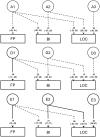Genetic and environmental influences on the relationship between flow proneness, locus of control and behavioral inhibition
- PMID: 23133606
- PMCID: PMC3487896
- DOI: 10.1371/journal.pone.0047958
Genetic and environmental influences on the relationship between flow proneness, locus of control and behavioral inhibition
Abstract
Flow is a psychological state of high but subjectively effortless attention that typically occurs during active performance of challenging tasks and is accompanied by a sense of automaticity, high control, low self-awareness, and enjoyment. Flow proneness is associated with traits and behaviors related to low neuroticism such as emotional stability, conscientiousness, active coping, self-esteem and life satisfaction. Little is known about the genetic architecture of flow proneness, behavioral inhibition and locus of control--traits also associated with neuroticism--and their interrelation. Here, we hypothesized that individuals low in behavioral inhibition and with an internal locus of control would be more likely to experience flow and explored the genetic and environmental architecture of the relationship between the three variables. Behavioral inhibition and locus of control was measured in a large population sample of 3,375 full twin pairs and 4,527 single twins, about 26% of whom also scored the flow proneness questionnaire. Findings revealed significant but relatively low correlations between the three traits and moderate heritability estimates of .41, .45, and .30 for flow proneness, behavioral inhibition, and locus of control, respectively, with some indication of non-additive genetic influences. For behavioral inhibition we found significant sex differences in heritability, with females showing a higher estimate including significant non-additive genetic influences, while in males the entire heritability was due to additive genetic variance. We also found a mainly genetically mediated relationship between the three traits, suggesting that individuals who are genetically predisposed to experience flow, show less behavioral inhibition (less anxious) and feel that they are in control of their own destiny (internal locus of control). We discuss that some of the genes underlying this relationship may include those influencing the function of dopaminergic neural systems.
Conflict of interest statement
Figures


References
-
- Csikszentmihalyi M, Csikszentmihalyi I (1988) Optimal experience. Psychological studies of flow in consciousness. Cambridge, England: Cambridge Univ Press.
-
- Csikszentmihalyi M, Nakamura J (2010) Effortless attention in everyday life: a systematic phenomenology. In: B. Bruya, Editor. Effortless attention: a new perspective in the cognitive science of attention and action. Cambridge, MA: The MIT Press. pp. 179–190.
-
- Jackson SA, Thomas PR, Marsh HW, Smethurst CJ (2001) Relationships between flow, self-concept, psychological skills, and performance. J Appl Sport Psychol 13: 129–153.
-
- Csikszentmihalyi M, Schneider B (2000) Becoming adult: how teenagers prepare for the world of work. New York: Basic Books.
-
- Asakawa K (2010) Flow experience, culture, and well-being: how do autotelic Japanese college students feel, behave, and think in their daily lives? Journal of Happiness Studies 11: 205–223.
Publication types
MeSH terms
LinkOut - more resources
Full Text Sources

